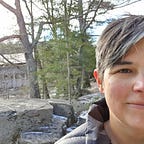50K in 50 States by 50 Years Old
Texas— 82.69Km, through December 2022
- 2016–2019: 24Km from 3 different trips to San Antonio, walking around the Riverwalk, Downtown, King William and Southtown.
- 2019: 8Km walking around Rockport.
- Dec 7, 8 and 12, 2022: 31.81Km Downtown Austin and exploring the recreation path along the Colorado River (photos and more photos)
- Dec 9, 10 and 11, 2022: 18.88Km in Rockport TX around the Goose Island State Park and the Aransas National Wildlife Refuge (photos)
Where to get some distance in Texas
Texas is huge, obviously. I’ve so far spent most of my time exploring San Antonio, Rockport and Austin, and once made the drive west on I-10 heading to New Mexico. Like most of the states I’ve visited, I’ve barely scratched the surface.
- San Antonio’s King William and Southtown neighborhoods are — or at least were a couple of years ago — great areas to explore on foot, with plenty of excellent food and drink, a thriving community, and easy access to the downtown/tourist areas. You can easily follow the river right to downtown.
- Austin’s recreation path along the river is stunning, and about an 8 mile loop from what I could tell. Shore birds, bats, kayaking, runners, plenty of trees all within a few meters of any kind of food and beverage you could hope for. Terrain: paved or hard-packed dirt with some boardwalk, and flat. Fair warning, the few public bathrooms are pretty disgusting and there aren’t many.
- The Aransas National Wildlife Refuge has a long loop road that I did not walk, but could easily be walked. There are plenty of trails, tons of deer and other wildlife, and it’s a birding hotspot. But be warned — in addition to no bathrooms, the mosquitos are aggressive and plentiful. Terrain: paved roadway, very flat.
Celebrating Texas’ Indigenous Voices
Texas is not only huge, it has an extremely complex history like all the other Southwest states that were annexed from Mexico. And like all Indigenous people of this region, the Indigenous people of Texas have been dealing with this complex history for centuries.
I am finding myself in real difficulty even trying to write this piece. It’s likely because Texas is very personal for me. I never set foot in the state until my 40s when I found my biological family, whose roots are deep in Texas and whose identity is tied to all of this complexity and history.
So I’ll offer some historic takes that are helpful for context:
- The racial caste system of the Mexican government categorized and documented people as European, Indigenous or of African descent, setting up a structure during the first wave of colonial rule in this region
- In the 1840s, tens of thousands of people went from being Mexican citizens to being US residents at the stroke of a pen. As it had with countless other treaties, the US promptly broke the spirit and letter of their agreement with Mexico and stole a lot of land from a lot of people.
- In the intervening years, politics, racism, and pragmatism have all intermixed into a very nuanced current reality for people of Mexican and Indigenous descent
In the present day, organizations like the Society of Native Nations help educate people that there are still many Indigenous people in Texas who were the original inhabitants of the land. The federally recognized nations in Texas were removed from their own lands and settled in Texas, while the many different groups who have called Texas home for millennia are largely unacknowledged.
The Alma de Mujer Center for Social Change in Austin provides a retreat center and supports the self-determination of Indigenous women, families, and communities. By providing space where Indigenous leaders can gather, the Center facilitates both healing and forward-looking social change.
In San Antonio, the American Indians in Texas at the Spanish Colonial Missions provide education and cultural preservation of the Tap Pilam and other groups whose history is often erased or glossed over by the missions that attract tourists to this region. The AITSCM ensures that Indigenous people’s stories are also told.
And the Texas Tribal Buffalo Project is reconnecting the Lipan Apache with the buffalo that were once an integral part of life for nearly all Indigenous people. The Nature Conservancy has a fantastic article about the history of the project and what it means for buffalo to be re-introduced in Texas.
I have set myself a goal of completing at least 50Km in all 50 states by the time I’m 50. To acknowledge that I’m traveling on land that was stolen from others, I am donating $500 to the First Nations Development Institute for each state I complete.
Thank you for reading and supporting me on this journey. If you’re able to chip in — for your state, or for all 50 states — you’ll help me double the impact I’m able to make on my own.
If you’re from Texas or living there right now, please consider supporting the Alma de Mujer Center for Social Change, the Texas Tribal Buffalo Project, or donating to another local and indigenous-led organization.
